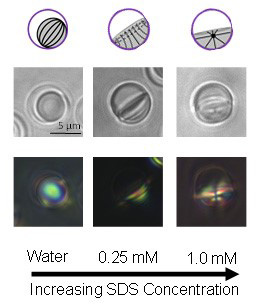 General Overview: Researchers at the Wisconsin MRSEC are working to develop sensors that can detect toxic substances near a single cell by exploiting the unique properties of liquid crystals (LC). LCs are materials that combine physical properties of both liquids and solids, and they have been widely used for displays (LCDs) in electronic devices because the LCs reorganize in response to external stimuli such as electric fields. Recently, Wisconsin MRSEC researchers discovered a method to encapsulate or “cage” tiny LC droplets inside a polymer capsule. When the encapsulated LC droplets are exposed to external stimuli, such as small cell-toxic molecules, the LC reorganizes inside the cage resulting in changes in visual appearance (see Figure). This advance, combined with methods to engineer the chemistry of the capsules, allowed “caged” LC droplets to be attached to single cells and used to report the presence of toxic substances in the local environment of the cells.
General Overview: Researchers at the Wisconsin MRSEC are working to develop sensors that can detect toxic substances near a single cell by exploiting the unique properties of liquid crystals (LC). LCs are materials that combine physical properties of both liquids and solids, and they have been widely used for displays (LCDs) in electronic devices because the LCs reorganize in response to external stimuli such as electric fields. Recently, Wisconsin MRSEC researchers discovered a method to encapsulate or “cage” tiny LC droplets inside a polymer capsule. When the encapsulated LC droplets are exposed to external stimuli, such as small cell-toxic molecules, the LC reorganizes inside the cage resulting in changes in visual appearance (see Figure). This advance, combined with methods to engineer the chemistry of the capsules, allowed “caged” LC droplets to be attached to single cells and used to report the presence of toxic substances in the local environment of the cells.
Technical Description: The Wisconsin MRSEC has recently discovered a method to encapsulate or “cage” micrometer-sized liquid crystal (LC) droplets inside microcapsules prepared by ‘reactive/covalent’ assembly of azlactone-functionalized polymer multilayers. When exposed to interfacially active molecules, the caged LC droplets can be programmed to increasingly wet or dewet the inner surface of the capsule, resulting in a series of complex droplet shapes, including lenses, hemispheres, and concave hemispheres. Concurrent with the wetting transition, the internal configurational states of the LC were also observed to change, thus revealing that the caging of LC droplets can be used to generated ordering and wetting transitions not seen with free LC droplets. The response of the LC within the capsules reflects a delicate balance of elastic and surface anchoring energies and capillary stresses, and thus provides new designs of responsive soft matter. Because the LC droplets are encapsulated, they can be attached to living mammalian cells and be used report the presence of local concentrations of cytotoxic molecules in the local environments of single cells.